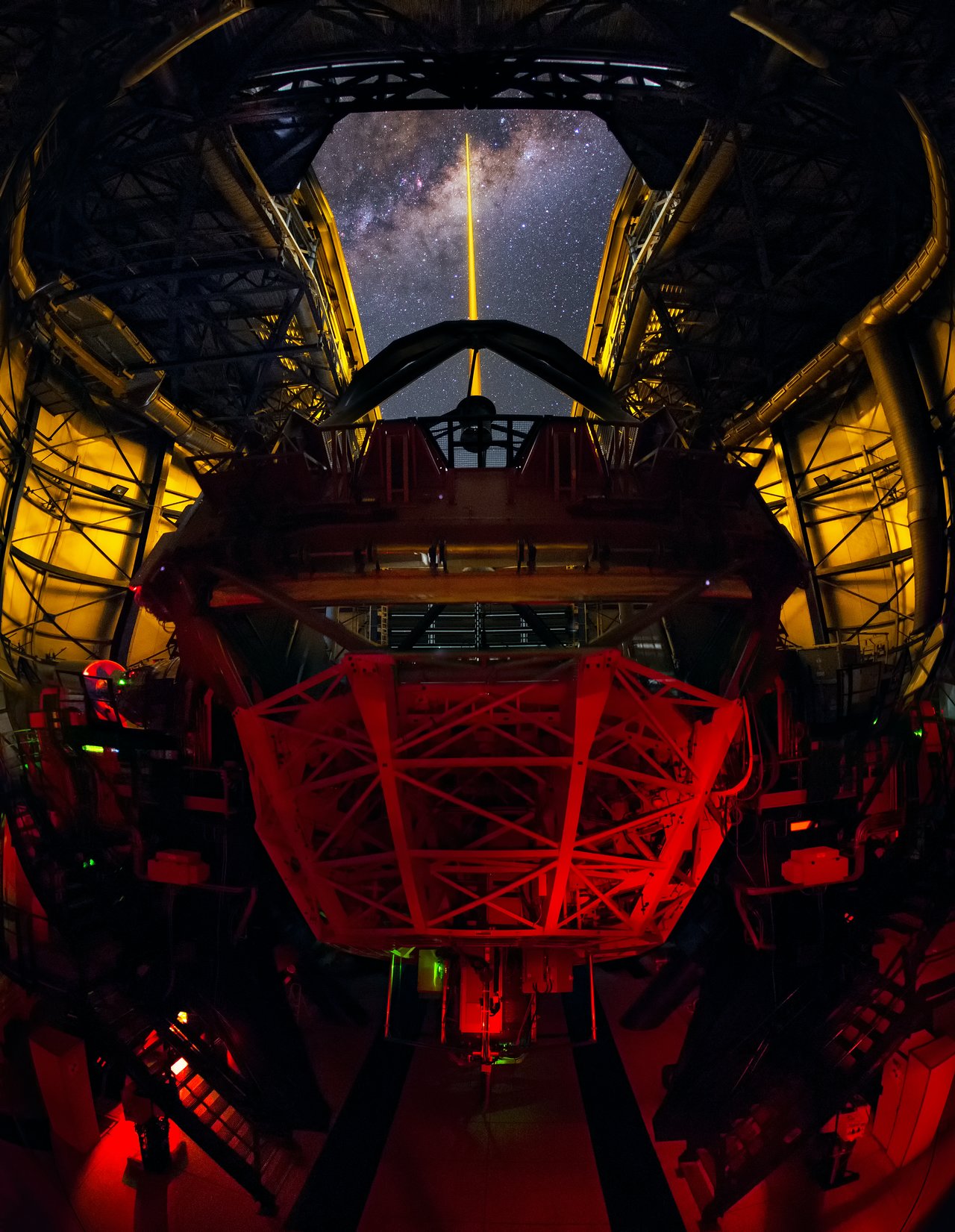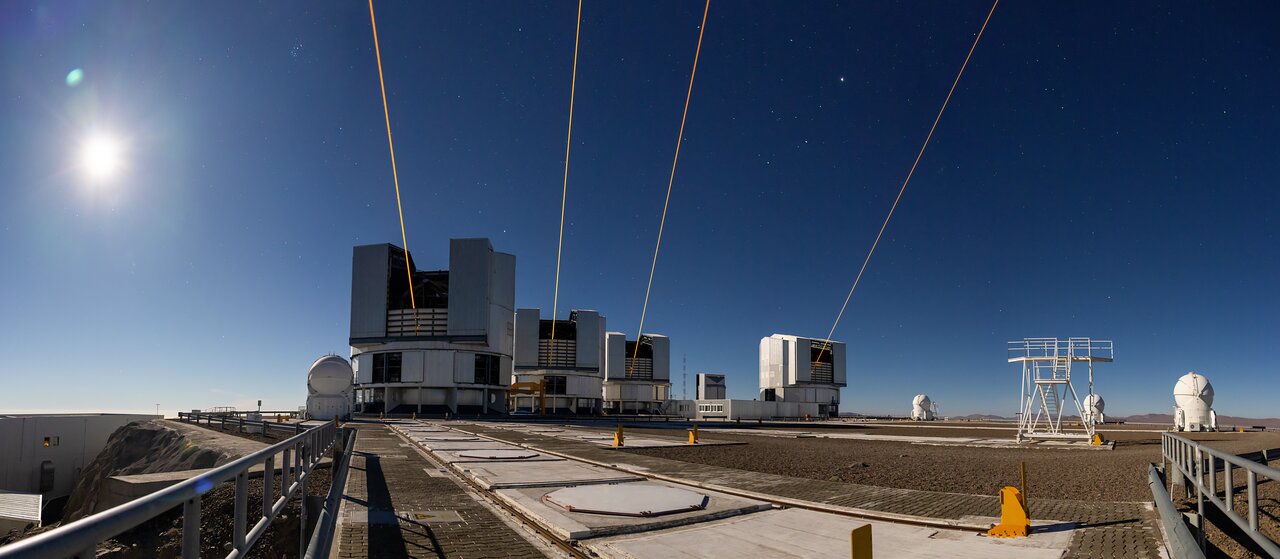« If this could work in practice, it would be a revolutionary breakthrough »

This sentence appeared in the final report of the Very Large Telescope Project in 1986, one year before the official launch of one of the world’s largest observatories : the Very Large Telescope (VLT). Nearly forty years later, this vision has become a reality !
Consisting of four 8.2-meter main telescopes and four 1.8-meter auxiliary telescopes, the VLT is now the world’s most advanced ground-based astronomical observatory in the optical domain. The VLTI (Very Large Telescope Interferometer) is a mode of operation of the VLT that combines the light from several telescopes using interferometry. This method allows the VLT to observe the sky with a level of detail equivalent to that of a single giant telescope, whose diameter would correspond to the greatest distance between the telescopes.
However, despite the performance of interferometry and the fact that the VLT is located under one of the clearest skies on the planet—in the Atacama Desert in northern Chile—the Earth’s atmosphere is not a stable environment. It is made up of turbulent layers of air that distort the light from celestial objects, causing the famous twinkling of stars visible to the naked eye. To correct for these disturbances, astronomers have developed adaptive optics, which involves analyzing atmospheric turbulence in real time using a bright reference star. A deformable mirror located in each telescope is adjusted several thousand times per second, compensating for the disturbances suffered by the light and producing images as sharp as if they had been taken in space.
This technique has long been limited by the need for a reference star close to the observed target. So what can be done when there are no bright stars nearby ? The solution is ingenious : create one ! Powerful laser beams are emitted from the telescopes to excite sodium atoms in the upper atmosphere, creating an artificial star at an altitude of about 90 km. This star then serves as a reference point to correct for turbulence anywhere in the sky, opening up the entire southern sky to VLT observations and making the VLTI the most powerful optical interferometer in the world.
Thanks to this breakthrough, the GRAVITY interferometric instrument, developed in part by LIRA teams, has been able to accomplish remarkable feats since 2016 : imaging exoplanets, observing nearby and distant stars, and studying in detail faint objects orbiting the supermassive black hole at the center of the Milky Way.
And that makes four !

Until recently, only one of the VLT telescopes was equipped with lasers of this type. Adaptive optics based on an artificial star was therefore only possible with this telescope, preventing the combined power of the four giants from being fully exploited. The installation of a laser on each of the three other telescopes represents a major achievement of this project, completed in record time (only five years !), taking the GRAVITY instrument to a new level of performance with GRAVITY+.
"With the arrival of laser stars, we are realizing the ’VLTI extended array’ envisaged in 1989 by the pioneers of the VLT, including Pierre Léna, founder of our world-renowned interferometry and adaptive optics team at LIRA," says Thibaut Paumard, CNRS researcher at LIRA – Paris Observatory-PSL, coordinator and co-investigator of the French contribution to GRAVITY+.
Thanks to these new capabilities, the amount of light collected and transmitted in the instrument increases significantly, making GRAVITY+ up to ten times more sensitive. This increased performance will make it possible to observe isolated stellar black holes, rogue planets that do not orbit any star, and measure the mass of thousands of black holes at the heart of distant galaxies.
"GRAVITY+ ushers in a visual revolution that heralds an astronomical revolution, achieving unprecedented sensitivity and integration depth at such angular resolution," explains Miguel Montargès, assistant astronomer at LIRA – Observatoire de Paris-PSL and member of the instrument qualification and verification team.
For their first test observations with the new lasers, the GRAVITY+ and ESO teams at Paranal chose to target the Tarantula Nebula, a vast star-forming region located in one of our satellite galaxies, the Large Magellanic Cloud. These initial data revealed that a bright object in the nebula, previously thought to be a single star, is actually a binary system consisting of two stars very close to each other. This discovery spectacularly illustrates the new capabilities of the VLTI and the exceptional scientific potential offered by its upgraded version.
"With these four laser stars, GRAVITY+ has achieved what the pioneers who conceived the VLTI had imagined. The prospect of increasing GRAVITY’s sensitivity to discover new stars closer to the supermassive central black hole is very exciting, especially for the LIRA team, one of whose objectives is to measure the spin of the black hole using such stars," adds Guy Perrin, astronomer at LIRA – Observatoire de Paris-PSL, national coordinator and co-investigator of the GRAVITY project.
LIRA contacts : Thibaut PAUMARD, Guy PERRIN, Roderick DEMBET
Find out more :


